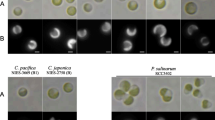Abstract
Prochlorophyta, suggested as a new division of prokaryotes1, lack phycobilin pigments characteristic of cyanobacteria, but contain chlorophyll b as well as chlorophyll a, characteristic of green algae and higher plants. Since the description of Prochloron didemni as the type species for this division2, no other genera or species have been added to the group. The only published accounts of Prochloron are obligate symbionts of didemnid ascidians3, which are difficult to grow in the absence of their hosts4. Consequently, research on their cell composition and physiology has been handi-capped. Here, we report a second prochlorophyte. This organism is one of the dominant species in the shallow eutrophic Loosdrecht lakes in The Netherlands, from which it was isolated in 1984. Unlike Prochloron, the newly isolated species is filamentous and planktonic. Detailed investigation of its cell structure, composition and physiology is possible as it can easily be grown in a mineral medium.
Similar content being viewed by others
References
Lewin, R. A. Nature 261, 697–698 (1976).
Lewin, R. A. Phycologia 16, 217 (1977).
Lewin, R. A. Phycologia 23, 203–208 (1984).
Patterson, G. M. & Withers, N. W. Science 217, 1934–1935 (1982).
Van Liere, L. & Mur, L. R. Mitt. int. Verein. theor. angew. Limnol. 21, 158–167 (1978).
Korthals, H. J. & Steenbergen, C. L. M. FEMS Microbiol. Ecol. 31, 177–185 (1985).
Strain, H. H & Svec, W. A. in The Chlorophylls (eds Vernon, L. P. & Seely, G. R.) 21–66 (Academic, New York, 1966).
Hager, A. & Stransky, H. Archs Microbiol. 72, 66–83 (1970).
Withers, N. W. et al. Proc. natn. Acad. Sci. U.S.A. 75, 2301–2305 (1978).
Tandeau de Marsac, N. J. Bact. 130, 82–91 (1977).
Stransky, H. & Hager, A. Archs Microbiol. 72, 84–96 (1970).
Hertzberg, S., Liaaen-Jensen, S. & Siegelman, H. W. Phytochemistry 10, 3121–3127 (1971).
Van Dijken, J. P., Veenhuis, M., Kreger-Van Rij, N. J. W. & Harder, W. Archs Microbiol. 102, 41–44 (1975).
Codd, G. A. & Marsden, W. J. N. Biol. Rev. 59, 389–422 (1984).
Drews, G. & Weckesser, J. in The Biology of Cyanobacteria (eds Carr, N. G. & Whitton, B. A.) 333–358 (Blackwell Scientific, Oxford, 1982).
Franklin, T. J. & Snow, G. A. in Biochemistry of Antimicrobial Action, 22–55 (Chapman & Hall, London, 1975).
Author information
Authors and Affiliations
Rights and permissions
About this article
Cite this article
Burger-Wiersma, T., Veenhuis, M., Korthals, H. et al. A new prokaryote containing chlorophylls a and b. Nature 320, 262–264 (1986). https://doi.org/10.1038/320262a0
Received:
Accepted:
Issue Date:
DOI: https://doi.org/10.1038/320262a0
- Springer Nature Limited
This article is cited by
-
A novel species of the marine cyanobacterium Acaryochloris with a unique pigment content and lifestyle
Scientific Reports (2018)
-
Targeted delivery of fluorogenic peptide aptamers into live microalgae by femtosecond laser photoporation at single-cell resolution
Scientific Reports (2018)
-
Draft genome of Prochlorothrix hollandica CCAP 1490/1T (CALU1027), the chlorophyll a/b-containing filamentous cyanobacterium
Standards in Genomic Sciences (2016)
-
Unique chlorophylls in picoplankton Prochlorococcus sp. “Physicochemical properties of divinyl chlorophylls, and the discovery of monovinyl chlorophyll b as well as divinyl chlorophyll b in the species Prochlorococcus NIES-2086”
Photosynthesis Research (2016)
-
Establishment of the forward genetic analysis of the chlorophyll d-dominated cyanobacterium Acaryochloris marina MBIC 11017 by applying in vivo transposon mutagenesis system
Photosynthesis Research (2015)





